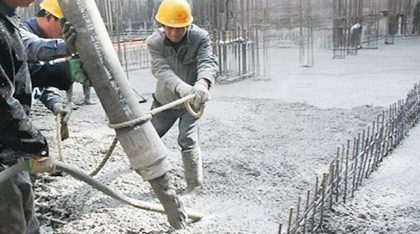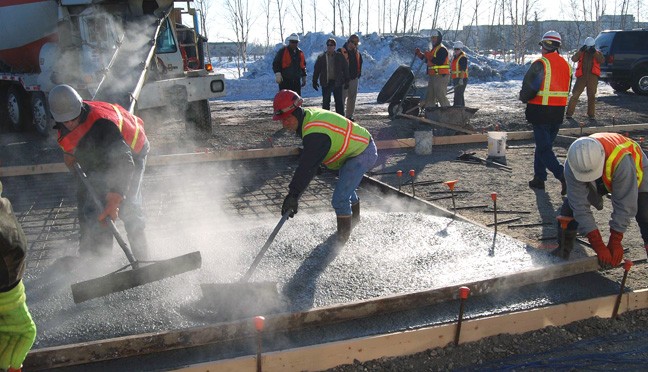If you know anything about concrete, you know two things — no two pouring jobs are the same, and companies located in wintry locations face a host of unique challenges. Concrete that freezes inside a hopper or boom can leave you with a solid and unusable pipeline that brings your job and your livelihood to a standstill.
So how can you avoid concrete freezing in cold weather? And how can you accommodate the unique safety and procedural challenges when you’re tasked with handling this in one of the world’s colder regions? Here are five ideas.
1. Mix concrete using very hot water
One of the most basic fixes for concrete that wants to freeze solid is to employ the use of very hot water to mix it. The South Carolina Department of Transportation makes these recommendations:
- At times when the atmospheric temperature is 50°F or below, the temperature of the batch of concrete must likewise be 50°F or above before being placed into the forms.
- Batching concrete in conditions below 35°F is not recommended, but may be accomplished by using water in the mixer heated to a temperature of not more than 170°F.
SCDOT also recommends that any aggregate materials containing frozen matter, including frost and ice, must not be used in the mixture. For the most part, however, working with heated water should prevent the slurry from freezing during delivery and pumping.
2. Use insulation to wrap the pipeline boom
Another fairly low-tech way to fight off frozen concrete during the winter is to wrap foam insulation around the pipeline’s boom. This may be done in conjunction with some of the other suggestions on this list, or on its own if the outside temperature is low but not in danger of approaching freezing. The tubular insulation, if firmly affixed without any gaps, should allow the concrete to retain some of its original heat while it’s being delivered and poured.

3. Pre-heat your boom pipeline
Whether or not they’ve chosen to insulate the boom, some companies choose the route of using the vehicle’s engine to pre-heat the pipeline and ensure a smooth flow of concrete. The exhaust stack in a typical concrete delivery truck provides more than enough heat for the job, so long as the boom operators have chosen a heat-resistant hose to redirect the engine’s waste heat and put it to work, ensuring the water in your concrete doesn’t freeze before it sets. When it’s done correctly, this technique should deliver consistent warmth throughout the pipeline all the way to the hopper’s exit.
4. Perform appropriate winterization on any external pipelines
Sometimes, the pipeline from the cement truck to the slab at the job site isn’t the only apparatus required to deliver concrete. Some job sites require the construction of a separate external pipeline.
If this is the case for you, make sure you know how to properly winterize and stage the components of the pipeline before and between pours. You can use heavy construction blankets to cover the pipeline when it’s not being used. For shorter runs, it might even make sense to disassemble the pipeline and store it inside and away from the elements at night. Unless these precautions are taken, upon starting up work the next day, you might find your slurry separating from the concrete and freezing to the inside walls of the pipe, slowing down your progress and significantly compromising the quality of the mix.

5. Remain mindful of — and train for — cold-weather safety
Your employees should feel confident and well-prepared whenever they’re called upon to perform a concrete pour in very cold or otherwise challenging conditions. This begins with issuing the right cold-weather clothing, including insulated gloves and coats.
Your team should never handle icy pipes with bare hands and care should always be taken when using the steps and decks on the pumping truck, as these too may have ice on them. As far as actually handling the pumping equipment, some of your standard training points are even more vital in the wintertime, such as avoiding kinks in the hoses, which can further reduce the flow of concrete.
The manufacturer of your pumping equipment and vehicles may prohibit their use in conditions lower than -10°F, and others may have set different temperature restrictions of their own. Ignoring these warnings — or failing to take their recommended precautionary measures — might cause the concrete boom to become weaker and more brittle. It might not fail immediately, but it could hang on long enough to fail during a routine job sometime later, during ordinary “boom bounce” and normal usage.

As a result, no matter your experience level, always defer to the manufacturer’s instructions and restrictions. You don’t want to lose considerable time and money by abusing your equipment or using it out-of-season, not to mention risk injuries or delay the job’s completion because you thought you knew better or tried to cut corners.
Last thoughts on wintertime concrete pouring
The good news about pouring concrete in cold weather is that, if your concrete does freeze, that means it’s also stopped setting. Nevertheless, if this happens to you, you’ll need to move your truck someplace warm so it can be cleaned out and a fresh batch of concrete readied instead. Nobody wants to lose a whole batch of concrete, but you might need to try more than one of the above techniques before you find one that suits you.
Most importantly, remember to communicate effectively with everybody involved in the process and ensure your training programs account for temperature extremes and the related headaches.








